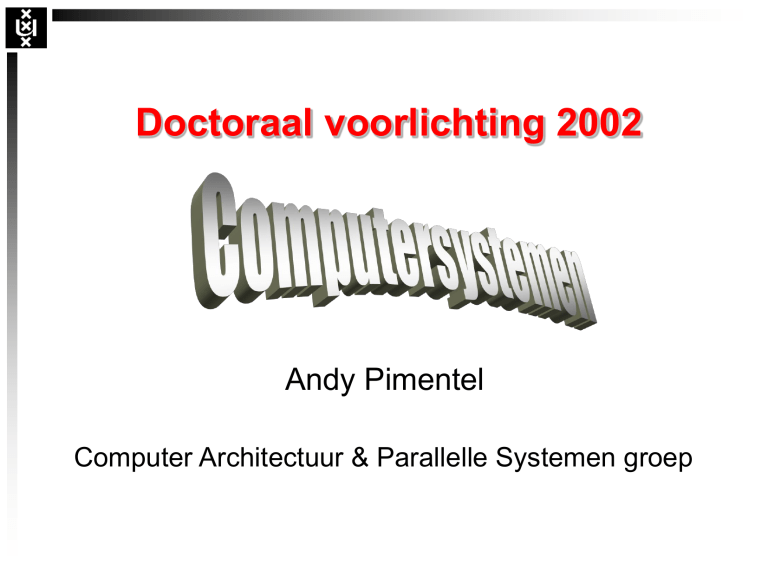
Doctoraal voorlichting 2002
Andy Pimentel
Computer Architectuur & Parallelle Systemen groep
Een globaal overzicht
Groepsleider: Prof. Dr L.O. Hertzberger
Het onderzoek concentreert zich op
computer architectuur als integraal concept,
wat inhoudt dat applicatie, compiler, OS en
hardware in het geheel worden beschouwd
Op dit moment 5 onderzoeksthema’s
Computer
architectuur modellering en simulatie
Grid computing
Federated databases
Traffic applications
Advanced Internet technology
Architectuur modellering en
simulatie
Verantwoordelijk docent: dr. A.D. Pimentel
([email protected])
Het ontwerp van methoden en technieken
voor computer architectuur simulatie
Enkele
trefwoorden voor dit onderzoek:
Modellerings
methodology
Abstractie niveau(s)
Experimentatie
Validatie
Mixed-level simulatie
Nauwe samenwerking met: Philips Research,
Universiteit Leiden en TU Delft
Later meer...
Grid Computing
Verantwoordelijk docent: dr. A. Belloum
([email protected])
Prestatie analyse tests op een Grid testbed,
(grafische) user interfaces voor Grid gebruikers
en de ontwikkeling van een collaboratief
systeem voor grid-gebaseerde applicaties
Enkele
trefwoorden voor dit onderzoek:
Grid
technology
Human-computer interaction
Scheduling voor Grid systemen
Collaboratieve systemen
Samenwerking met: Nikhef, SARA, Amolf
URL: VLABWWW.nikhef.nl/VLAM-G/
Federated databases
Verantwoordelijk docent: dr. H. Afsarmanesh
([email protected])
Ontwerp en ontwikkeling van software
architecturen die “inter-operability” en integratie
van cooperatieve informatie systemen
ondersteunen
Enkele
trefwoorden voor dit onderzoek:
Interoperable
en cooperatieve informatie systemen
Informatie en service brokerage
Integratie van bestaande multi-databases
High-performance webserver / database integratie
Samenwerking met: o.a. AMC,Unilever, Nikhef
URL: www.science.uva.nl/~netpeer/
Traffic applications
Verantwoordelijk docent: drs. A. Visser
([email protected])
Onderzoek naar onderwerpen gerelateerd
aan mobiliteit: de operationele architectuur
van de mobiele robot MARIE, modellering en
analyse van sensor systemen langs wegen
Enkele
trefwoorden voor dit onderzoek:
Toegepast
onderzoek
Mobiliteit
Embodied
computer systemen
URL: www.science.uva.nl/~arnoud/research/
+ www.science.uva.nl/~arnoud/projects/
Advanced Internet Technology
Verantwoordelijk docent: dr. C. de Laat
([email protected])
Onderzoek naar het Next Generation Internet
en grid-enabling technologie
Enkele
trefwoorden voor dit onderzoek:
Optische
netwerken voor Grid applicaties
Autenticatie, autorisatie en accounting (AAA) modellering
Intelligente netwerk devices
Optimalisatie, meten, monitoren, geavanceerde protocol
stacks (voor high-bandwidth connecties over lange
afstanden)
URL: www.science.uva.nl/~delaat/
Een greep uit de beschikbare
afstudeer projecten
Traffic simulation of vehicles with a shape
Reserveringsrijden: het beter benutten van de weg
door het reserveren van ruimte
Stream data prefetching for (multimedia)
processors
Validation of abstract architecture models of
embedded media systems
Integrating the SimpleScalar simulator into
Sesame
Predicting the impact of large public events on
congestion
Optical networking for Grid applications
Vakkenpakket
Verplicht
Advanced
Computer Architecture (7 ptn, 10 ECTS)
voorheen
Architectuur-compiler interactie
Embedded
Systems (7 ptn, 10 ECTS)
Verplicht 7 ptn uit volgende vakken
Ontwerp
en organisatie van autonome systemen
(7 ptn, 10 ECTS)
Parallel wetenschappelijk rekenen en simulatie (7 ptn,
10 ECTS)
Databases en webgebaseerde toepassingen (7 ptn,
10 ECTS)
Aangeraden
O.a.
Computernetwerken en gespreide systemen
(beide VU)
Perspectieven
IT industrie
b.v.
KPN, ACE, Philips, CMG, OCE, Ericson,
Getronics, etc.
Onderzoeksinstituten
zoals
NLR en TNO
Banken
Freelance, eigen bedrijf
Onderwijs, Universiteiten, Overheid
A bit more on research
in my group
(computer architecture modeling
and simulation)
Trends in embedded system design
Observations
Modern
embedded systems for media and signal
processing must support multiple applications and
various standards for which they often should
provide real-time performance
These
systems increasingly have heterogeneous
system architectures, integrating
dedicated
hardware
embedded
processor cores
reconfigurable
Increasing
components (e.g. FPGAs)
silicon budgets
Integration
of functions: Systems on Chip
Complexity of system design is increasing
“Jumping down” the design
pyramid
High
Specification
Low
Abstraction
Abstract executable models
Cycle-true simulation models
Effort
Back-of-the-envelope calculations
10000
lines
Mins/
hours
Synthesizable RTL models
10000+
lines
Hours/
days
Low
High
Alternative realizations
Design by stepwise refinement
High
Specification
Explore
Low
Back-of-the-envelope calculations
1000
lines
Effort
Abstraction
Abstract executable models
Cycle-true simulation models
Secs/
minutes
10000
lines
Mins/
hours
Synthesizable RTL models
10000+
lines
Hours/
days
Low
High
Alternative realizations
The Artemis architecture
simulation environment
Performance evaluation of instantiations of
embedded systems architectures
Including
different
application-architecture
mappings: which component does
what?
HW/SW partitionings: which application task(s) is/are
performed in SW and which one(s) in HW?
At
multiple levels of abstraction
For a broad range of multi-media applications
We target the early design stages
Quick
and flexible model construction
Easy
re-use of models and model components (e.g.,
library approach)
Fast
simulations (large design space)
Y-chart Based Methodology
Applications
Architecture
Mapping
Performance
Analysis
Performance
Numbers
Use separate models for application and architecture behavior
Modeling and simulation
methodology
Application model
Description of functional behavior of
application
Independent from architecture, HW/SW
partitioning and timing characteristics
Generates application events
representing the workload imposed on
the architecture
Traces of
application
events
Architecture model
Parameterized timing behaviour of
architecture components
Models timing consequences of
application events
Application
model
Architecture
model
Explicit mapping of application and architecture models
Trace-driven co-simulation
Easy reuse of both application and architecture models!
Application modeling
Applying the Kahn process networks model
of computation
Parallel
processes communicating with each other
via unbounded FIFO channels
expresses
parallelism in an application and makes
communication explicit
Generation of application events:
Code
is instrumented with annotations describing
computational actions
Reading from/writing to Kahn channels represent
communication behavior
Application events can be very coarse grain
like
“compute a matrix multiplication” or ”read/write a pixel
block”
Mapping the application model
Event queues are used
for mapping the appl.
event traces
two or more
event queues to one
architecture component is
possible: events are
scheduled
Kahn
process
Channel
Application
model
Mapping
Kahn channels are
mapped to
communication
components at
architecture level
Event
queue
Proc.
core
FIFO buffer
Proc.
core
Architecture
model
Bus
Architecture modeling
Construct architecture models from generic
building blocks (library approach)
Library
contains performance models for common
architecture components
processing
cores, communication media (like buses),
memories, etc.
Accounting
for functional behavior not necessary!
Architecture modeling starts at “black-box”level
Processing
cores can model timing behavior of SW, HW
or reconfigurable execution
parameterizable
latencies for the application events
SW execution: high latency, HW execution: low latency
Allows
for rapidly evaluating different HW/SW
partitionings!
Tot slot...
Http://www.science.uva.nl/research/arch/ (groeps info)
Http://www.science.uva.nl/research/graduate/ (afstudeer info)
Http://www.science.uva.nl/~andy/ (computer arch. simulatie)
Http://ce.et.tudelft.nl/artemis/ (Artemis project homepage)
Email [email protected] (of de desbetreffende docent)
voor verdere informatie












